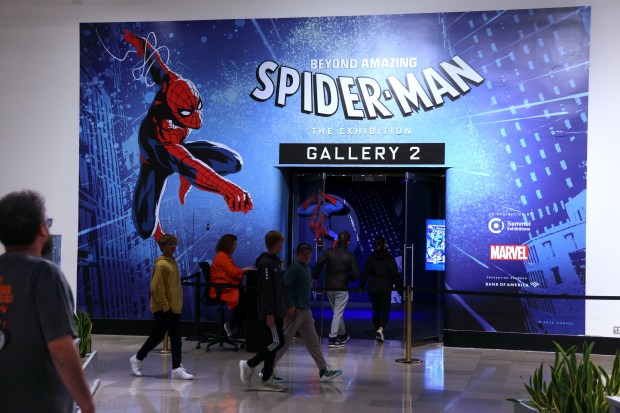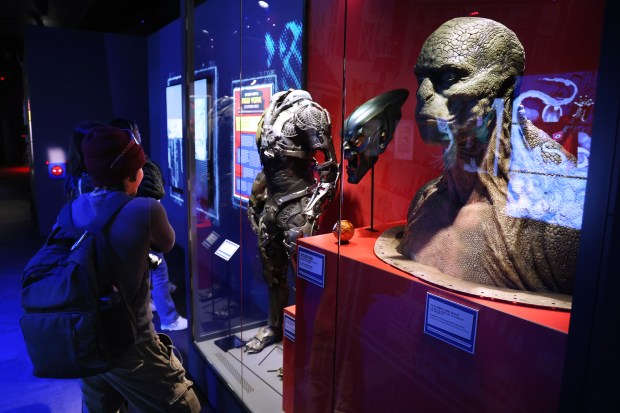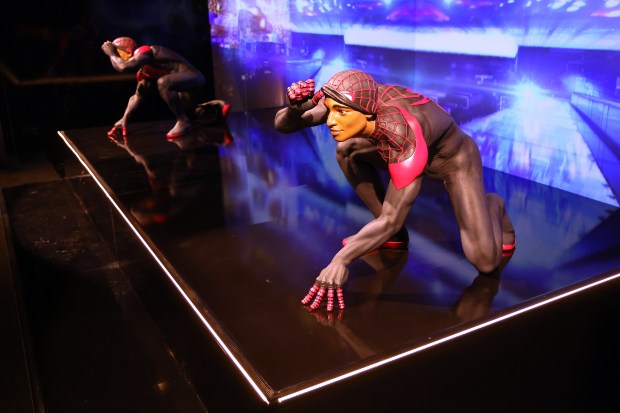Just inside the first gallery devoted to “Marvel’s Spider-Man: Beyond Amazing — The Exhibit” at the Griffin Museum of Science and Industry, there is a life-size Spider-Man statue or mannequin. I don’t know what you call this, but he looks real. He’s not, because he’s Spider-Man and Spider-Man is not real. But Spider-Man may as well be real. Most of us have never known a world without a web crawler patrolling Queens. Here, he’s bursting out of a comic book as if blasted out of a Spider-Cannon, fingers on his left hand curled into the universal symbol of web-based travel.
As I entered this room, I found myself unable to move on, as if hypnotized by the overlords of Marvel who have licensed it, or just the clever people who put together this somewhat thin but charming character celebration. Every patron in the exhibition is unable to move on. Most take a picture with Spider-Man, and everyone who does, every single one, shapes their own fingers into that Ozzy devil-horn thing and, as Spider-Man would, pretend to blast out a tendril of spider fluid.
“Give mommy the Spidey thing, baby,” a mom says.
Her daughter, so young she looks a step away from plopping backward, instinctively pulls her fingers into the iconic web-shooting pose and, being a Spider-Ham, adds a determined scowl.
“Do the finger thing,” says the next parent.
“Crouch down and give me a good web,” instructs the parent after that, and so on.
During a brief lull in preschoolers, a couple, probably in their 20s, furtively, quickly, with Spidey-esque dexterity, shoot pictures of themselves with Spider-Man best described as R-rated. Oh, Mary Jane! Only then did they add a sordid web-slinging gesture and bolt out of the gallery, giggling.
Spider-Man, see, means a lot of things to a lot of people.
Some of it just happens to be disgusting.
The exhibit — which doesn’t feature what you’d assume it might (there are no clips from Spidey films, only a handful of props and no halfhearted arguments for “the science of Spider-Man”) — is smartly centered on the endless interpretations of Spider-Man the Character who, despite being 64 years old, yet still a teenage spider, has remained remarkably mutable, able to bring in new generations of admirers many, many decades after his sell-by expiration date. Spider-Man is joined here, through archival artworks, trinkets, interactive kiosks and even more statues, by Spider-Rex, Spider-Ham, Spider-Gwen, Spider-Ben, Spider-Byte, Spider-Woman, Spider-Girl, Miles Morales, Madame Web, Spider-Zero, Victorian Spider-Man, Venom, Silk, Spider-UK, Spider-Man Noir, Spider-Wolf, Peni Parker, etc. You see, Spider-Man, explained curator Patrick A. Reed — nicely articulating the endurance of any pop juggernaut — “is a long-form communal work of art.”
Or, in this case, “a Spider-Mythos.”
What is not included here in that mythos — strangely for a show committed wisely to the construction of a character and the artists who shepherded it — is the decades-old debate over who created Spider-Man. Let me back up: It’s there silently, between well-chosen comic-book panels and reams of wall text. This, I guess, is the problem with museum shows in need of corporate permissions to deliver even an outline of their story: You’re never sure how the sausage gets made.
Spider-Man the Exhibit, through test drawings and uncompleted comic pages and some breezy writing, smartly illustrates how Spidey became a watershed in pop culture, even something of a progressive: Peter Parker answered to a Black boss in 1967 (Robbie Robertson, editor-in-chief of the Daily Bugle, and not to be confused with Robbie Robertson, the late guitarist/songwriter of the Band). Peter Parker was a teen hero at a time when comic books portrayed teens as sidekicks. Peter Parker, bitten by a radioactive spider and made unimaginatively strong and nimble, still can’t outrun money issues, problems with school, philosophical questions about what it means to be so blessed. Even among more respectable children’s literature from its time, Peter was a thoughtful creation, his architects never hesitating to use his famous credo: With great power comes great responsibility. “Beyond Amazing” is centered on milestones and mythology, including that line: We see (again, using archival drawings and lots of description) how a cry of decency was never so clear to Peter. We see how, again and again and again, he gives up the Spider-Man costume.
The irony being, real-world decency was even harder to come by behind the scenes.
The exhibit is divided into two large rooms. The first is dedicated to building the character; the other to its ripening and expansion. But the best part comes early, in a series of original comics and art that illuminate the tentative steps to Spider-Man.
There’s an issue of “Journey Into Mystery” No. 73, featuring a classic ‘50s radioactive invertebrate. (The cover screams: “WHERE WILL YOU BE WHEN THE SPIDER STRIKES?”) Alongside that, sample images of Aunt May and Uncle Ben in a different comic, months before Spider-Man’s debut. We see Stan Lee asked artist Steve Ditko to work on a comic now awkwardly-titled “Amazing Adult Fantasy,” sold as “The magazine that respects your intelligence.” We notice Lee and Ditko listed as co-creators throughout, but nothing on the lingering animosity that credit caused: Lee, a master showman and promoter of Stan Lee, would accept decades of praise for Spider-Man (and other Marvel heroes). Meanwhile, artists such as Ditko (who created the costume and look of Spidey and much of the basic mythology) were mostly known to die-hards.

We hear nothing about the years of lawsuits.
We do get a single hilariously revealing page of notes from Lee to an artist that says more about the early Marvel assembly lines than nearly anything else in “Beyond Amazing.” Lee was an editor, writer, ringleader and often the initial spark for a new character: What about a blind lawyer who fights crime using his other hypersensitive senses and was kind of a daredevil? What about a fantastic family of four transformed into crime fighters? Lee would write a synopsis of an issue and send it to an artist, who would then interpret it into a comic. The page on display at the MSI, from 1969, shows how Lee evaluated an issue then, after picking over images, he filled in dialogue. He also offered directions such as: “Unless we really NEED an exclamation point, I wanna try using PERIODS from now on, and see if this’ll give the mags a classier look…”
A museum staffer told me the exhibit fits well in the museum because it’s a show partly about the publishing industry and industry is in the very name of the building itself. And that’s not wrong. But what this sole page of notes suggests, and what is missing from much of “Beyond Amazing,” is a sense of the heat and friction generated when imagination gets shaped by a committee. Indeed, for so long, the Marvel company (like its main competitor, DC Comics) showed so little reverence for its own output, there’s astonishingly little material from the process itself, beyond interviews with artists. A lot of the salvaged original art and mock-up covers that survived the first decades of superheroes are not held by Marvel or DC but a few prescient art collectors. The archival objects in this exhibit, Reed said, came courtesy of about eight collectors.
Film props, of course, are another story. There’s one of Doc Ock’s eight hands. Willem Dafoe’s Kabuki-like Green Goblin mask. Tom Holland’s Spidey suit. The camera Tobey Mcguire carried when he played Peter Parker. By the time the superhero movie bonanza began, no one in this business held their noses around a gold mine any longer. (So much so that one reason there are no film clips in “Beyond Amazing” is because of the harrowing cost and complication around nailing down likeness rights for movie stars.)

For the record, I like a good pop-culture museum show.
This isn’t a bad one. MSI returns to the well often: Walt Disney archives. Jim Henson archives. Charles Schulz archives. James Bond. The Spider-Man show is its second Marvel show in five years. The Field Museum has a Pokémon show next year; the Museum of Contemporary Art, which had a blockbuster with David Bowie, has Yoko Ono coming in October. All of those brand names are enduring examples of a creative vision. And yet, not one emerged from a vacuum. Now that hand-wringing over whether pop culture belongs in esteemed institutions has subsided, or just been steamrolled by the persistence of museum administrators, it’s fair to expect these institutions to bring more blood, sweat and tears to stories of how intellectual properties are assembled.
“Beyond Amazing” makes an admirable point overlooked in other shows like this: A character as ubiquitous as Spider-Man, whose balloon has floated across Manhattan every Thanksgiving Day for nearly 40 years now, transcends ownership — somewhat. A cynic would say that’s what licensing is for. And sure, one of the best parts of the exhibit is a display of merchandising and international translations and night lights and action figures and Ben Cooper costumes and even the very first Marvel-approved Spidey artifact — strangely enough, a 1965 jazz album by Freddie McCoy.
But then every doodad is a riff on a conversation started in 1961 by Steve Ditko and Stan Lee.
So are the drawings abandoned by visitors at the end of the exhibit. Look for them. Four drawing tables, baskets of pencils and paper, Marvel artists on video illustrating how to draw your own Wall Crawler. The day I was there, some people left behind artworks good enough for Marvel, and some left behind the sketchiest of sketches. Spidey in a White Sox uniform. Darth Spidey. Those tables were full, everyone quietly interpreting Spider-Man. That so many drawings would be left behind suggests not everyone was satisfied with their performance. Most weren’t. They had a vision, they executed it. The plan didn’t pan out. To make anything that lasts, never mind endures after seven decades, is improbable. To explain just how improbable demands great power and responsibility.
Otherwise, it’s marketing.
cborrelli@chicagotribune.com




